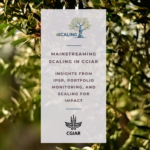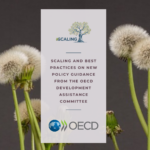Reposted from A concerted push to achieve the SDGs needs a practical scaling approach, 10/5/2023, https://www.brookings.edu/articles/a-concerted-push-to-achieve-the-sdgs-needs-a-practical-scaling-approach/
To achieve the sustainable development goals (SDGs), we need a concerted push to scale
In their recent opinion piece, Shameran Abed and Esther Duflo argue that “[e]xtreme poverty cannot be eradicated by relying on piecemeal development programming limited to the particular whims of different donors. Real progress on the 2030 Agenda requires a massive, concerted push to scale solutions that work.” We could not agree more. But policymakers and development practitioners require more specific guidance to on how such a “concerted push to scale” would work. We have some pragmatic suggestions.
We need a practical approach to achieve sustainable impact at scale
In a recent policy brief published by the Dag Hammarsköld Foundation and the United Nations, we note that so far, the common approach to achieving the SDGs has been to track progress on a global and country-by-country basis and to argue for policy change, for more investment, and more innovation. These are important elements of a strategy to achieve the SDGs, but what has been missing is to design, fund, and implement investment programs in a way that systematically and effectively supports the achievement of the SDGs.
Based on the experience with development programs that have successfully scaled and those that failed to scale, as distilled in the scaling principles of the international Scaling Community of Practice, we recommend that all projects and programs be designed and implemented to meet six key criteria:
- They define the development problem and long-term vision of scale to be attained and link it to the appropriate SDG target(s).
- They explore the role of an intervention by assessing how it will address the problem support a scaling pathway, and consider alternative solutions.
- They assess the intervention’s scalability in light of the enabling conditions for scaling, such as political support, policy reform, and available resources.
- They develop partnerships to support the achievement of scale by assuring the necessary technical and institutional capacity, funding, and political buy-in, as well as facilitating hand-off at the project end.
- They pay attention to sequencing, including proper piloting, continuity, and effective transitions, combining replication with policy/institutional reform, and adopting the appropriate sequencing of financing instruments.
- They monitor and evaluate progress along the scaling pathway and adapt as needed, ensuring a smooth transition from one project to the next and maintaining scaled-up impact.
Applying these six criteria is not rocket science. Plenty of examples exist, including agricultural development programs in China, high-land development programs in Peru, a conditional cash transfer program in Mexico, a global program for improved weather and climate observations, and of course Shameran Abed’s organization, BRAC. Unfortunately, most development programs, especially those supported by international funders, remain fragmented, one-off, and “pilots to nowhere.” What we need is for development institutions—governments, private businesses, social enterprises, NGOs, and international funders—to systematically adopt pragmatic scaling practices in project and program design, funding, implementation, and evaluation. This requires a change in the mindset of policymakers, implementers, and funders, in operational practice, in incentives, and in the evidence that informs decisionmaking. Effecting this institutional change is what is difficult, but we have lessons for governments and lessons for funders to draw on.
“Country platforms” and “multi-phase projects” are two specific approaches that can help countries and funders achieve the SDGs, as long as the principles and lessons of scaling are effectively incorporated. We briefly take a look at each with a scaling lens.
Country platforms offer a pathway to scale
“Country platforms” bring together in-country stakeholders and international funders in a concerted effort to support development and climate action. The U.N. and Kenya have joined forces on an SDG Partnership Platform to accelerate the attainment of the SDGs in Kenya. In the climate area, country platforms for a just energy transition (JET) have been established to reach ambitious climate goals in South Africa and replicated in Indonesia and Vietnam. Country platforms can serve as a means to pursue a scaling agenda for the achievement of the SDGs as long as:
- they have a clear longer-term vision of outcome goals against which the expected impacts of investment projects, policy reforms, and institution-building activities are measured;
- they are focused on narrower sectoral or sub-sectoral goals/areas, rather than on coordinating all-encompassing development efforts (past donor coordination efforts at a countrywide level have been of limited duration and success);
- they are country-owned and led;
- they have broad national cross-stakeholder engagement and ownership, to survive political cycles/ministerial changes in the country;
- funders commit to long-term engagement (rather than one-off project support), share information on their programs in a reasonably detailed and timely fashion, and harmonize their operational procedures vis-a-vis the country counterparts and each other; and
- individual funder projects and programs are designed, implemented, monitored, and evaluated with a clear view of how they contribute to the longer-term goals and systemic reform and institutional strengthening, and always focus on what happens beyond project end, i.e., what institution will continue to sustain and scale up the intervention after project end, what funding will be available for sustainability and scaling, and how winners and losers from the intervention can be mobilized to support rather than block sustainability and scaling.
Multi-phase projects offer scaling opportunities for funders and countries alike
Some development finance institutions, including the International Fund for Agricultural Development and the World Bank, have adopted a multi-phase project approach (MPA), in which they offer recipients a commitment to fund long-term development programs (10-12 years) with funding disbursed in 3-4 year tranches. The MPA (as reflected, for example, in the World Bank’s 2017 MPA report) embodies important principles of a sustainable scaling approach. It reflects the fact that there need to be longer-term outcome goals and that achieving these goals requires a time horizon beyond the usual lifetime of a project, and thus multiple sequential projects with adaptation, flexibility, and learning. It is based on the assumption that the funder stays engaged in this process throughout with finance and non-financial support.
However, the MPA would need to have a number of features not generally considered in the guidelines for MPAs, if it is to represent a true scaling approach. These include:
- assessing the scalability of the intervention;
- specifying the role of enabling conditions that need to be put in place to allow scaling to happen (institutional, policy, political, costs and financing, etc.);
- recognizing the importance of partnerships;
- considering whether and how the funding modalities may need to change as the scaling process proceeds; for example, an increasing share of financing may have to be shifted to government or private partners and the nature of financing may have to change from grants/loans to guarantees or equity contributions; and
- ensuring that the intervention is sustainable after the MPA ends.
Unfortunately, the traditional project approach remains prevalent since funders often have difficulty making the long-term funding commitments required by MPAs. Therefore, funders need to ensure that their stand-alone projects are not merely “islands of happiness,” but that project preparation, implementation, and evaluation focus on the long-term scale vision, that the intervention is sustainable and scalable, and that the enabling conditions are put in place to ensure that the sustainable scaling process continues after project end.




